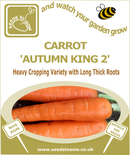Description
Carrot Autumn King 2 is a heavy cropping variety which produces deep orange, thick roots of 25-30cm long.
A great addition to your vegetable garden, this seed produces sweet, tasty carrots over a long harvesting period which store well over winter. Awarded the RHS Award of Garden Merit in 1995.
| When to sow | Sow successionally from March to August. |
| Where to sow | Carrots grow best in light, deep, fertile, well drained and stone free soil. If your soil is too heavy or compacted, they can be grown in a deep pot or container. Carrots do not like recently manured soils so beds are best prepared during the previous autumn. Sow carrot seeds, 1cm (1/2in) deep, in Rows 30cm apart outdoors. Cover early sowings with a fleece to protect from hard frosts. Sow the seeds as thinly as you can to minimise future thinning, which can attract carrot root fly. |
| What to do Next | When the seedlings start to show their first set of leaves, thin out leaving 5 to 7cm between each seedling. It is best to thin seedlings on a still evening after watering. Ensure that you remove all unused seedlings or alternatively, if you have sown thinly enough, wait until you have some young carrots which can be pulled to 'thin as you eat'. Use a fleece to cover seedlings to protect from carrot root fly. Water enough to ensure that soil does not dry out, but do not over water as this can encourage leaf rather than root growth. |
| Harvest | June to November.(approx. 70 days after sowing). Harvest in the evening by pulling out roots carefully or by using a hand fork to ease out the roots. Water soil before harvesting if the soil is dry. |
| Handy Tips | As carrot seeds are very small and difficult to handle, to aid in sowing thinly, mix the carrot seeds with a small amount of horticultural sand and sprinkle this mixture along a prepared seed drill. To further deter carrot root fly ( which are low flying) consider surrounding carrot bed with a fleece barrier at least 60cm high. Earth up around growing carrots to prevent green crowns. Ensure all carrots are harvested before first heavy frosts. Remove leaves 1cm above root and place in layers, covered by light sand and store somewhere cool and dry. |
| Companion Planting | Chives, Garlic, Rosemary, Sage, spring onion, Leeks and mint. |
| Nutritional Information | High in antioxidant beta-carotene which converts to vitamin A in the body. |
| Serving Suggestion | Home-grown carrots smell and taste sweeter than any shop bought variety and therefore they are delicious eaten raw in salads or as crudités with dips. They can be cooked and served in many ways (boiled, steamed, roasted, glazed, mashed, stir fried or made into soup or added to casseroles and cakes). Just avoid over cooking them to ensure they retain all their nutrients and beautiful sweetness. |
Payment & Security
Your payment information is processed securely. We do not store credit card details nor have access to your credit card information.


